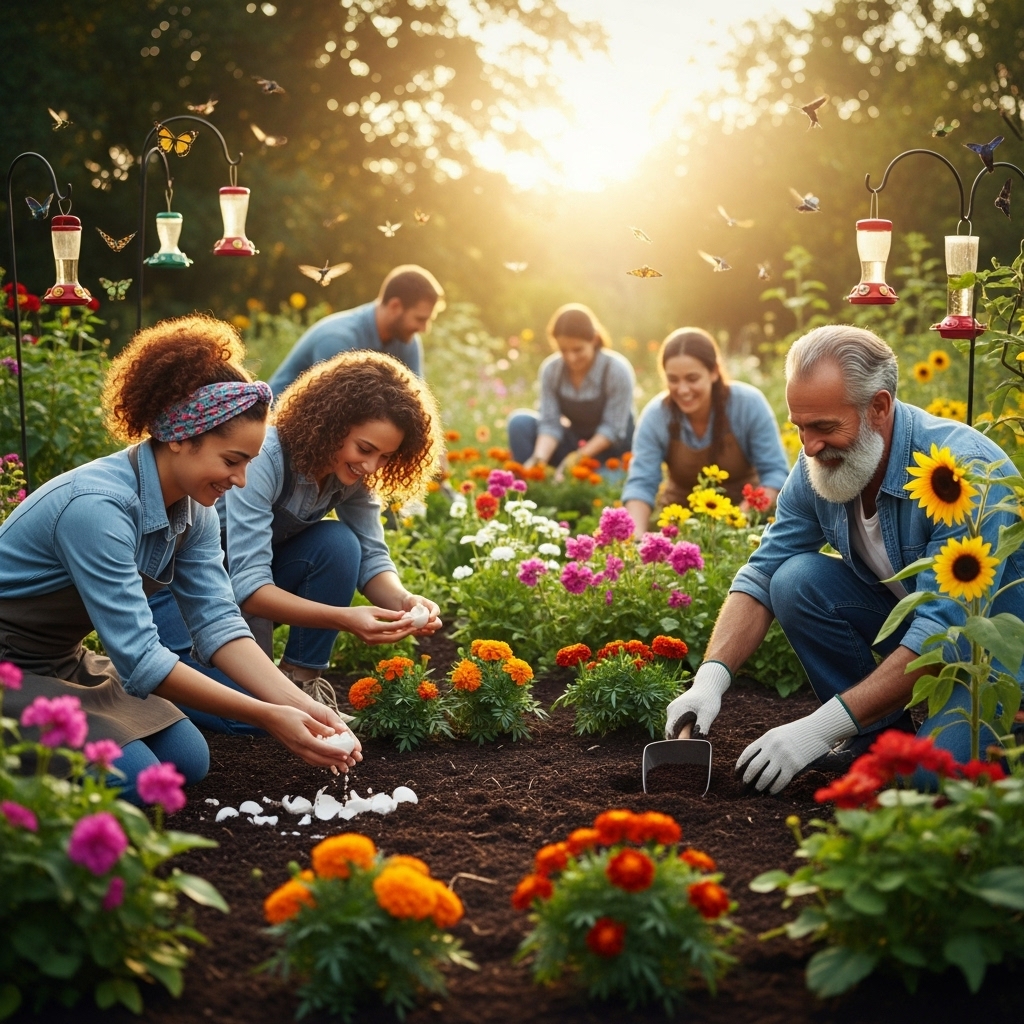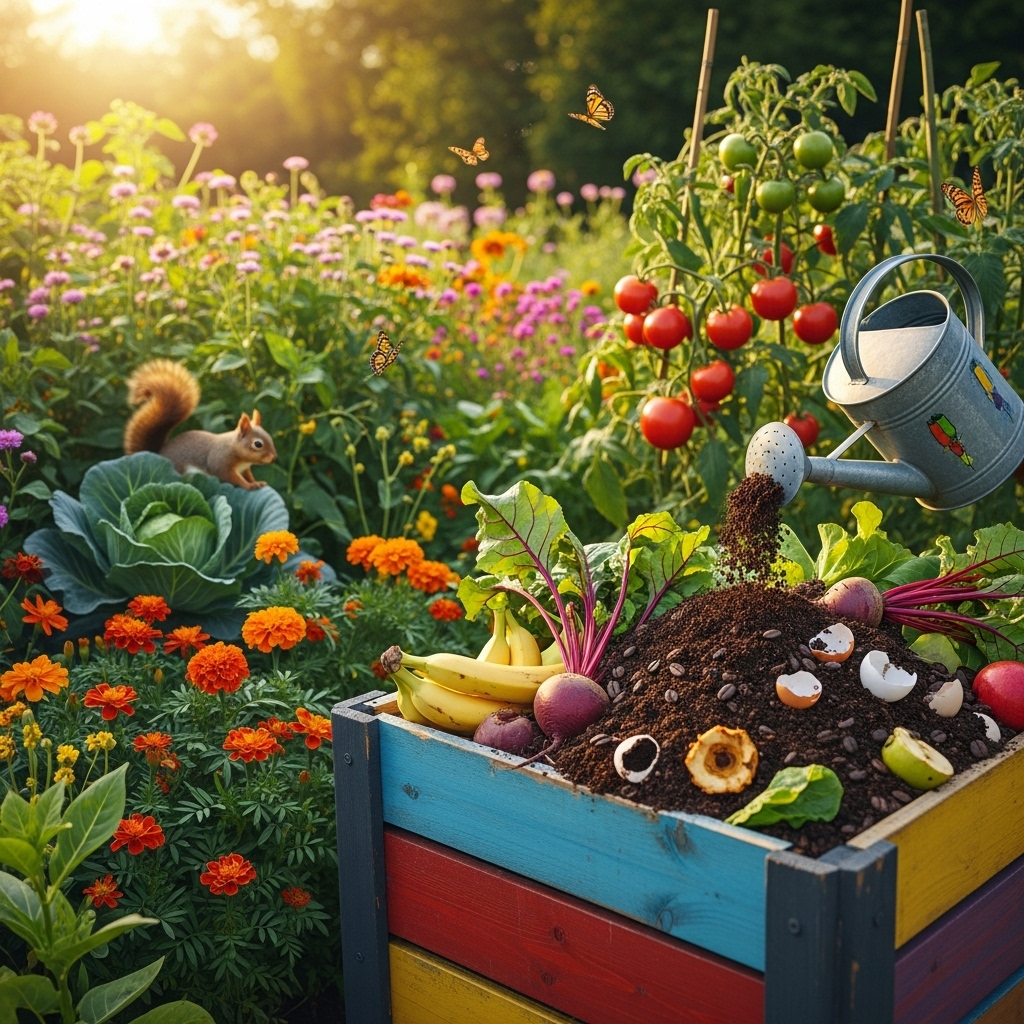Transforming kitchen scraps into garden gold is not just eco-friendly; it’s a rewarding journey that invigorates our blooms. Among the best natural fertilizers are eggshells and coffee grounds, packed with nutrients to help our flowers thrive.
Why Use Kitchen Scraps in the Garden?

Over the years, I’ve discovered the magic of repurposing kitchen scraps into wonderful resources for my garden. The idea of gardening is often associated with purchasing high-end fertilizers and soil amendments, but I have come to appreciate the simplicity and effectiveness of using what I already have at home. It not only saves money but also contributes to a healthier environment by reducing waste. Every time I crack an egg or brew a cup of coffee, I know I’m unlocking potential for my flowers to flourish. Let me take you through the benefits of using eggshells and coffee grounds, and how to incorporate them into your gardening routine.
The Nutritional Benefits of Eggshells
Eggshells are an incredible source of calcium carbonate, which is essential for the growth of strong plants. Calcium helps in the development of cell walls, making plants sturdier and more resilient against diseases. When I began adding crushed eggshells to my soil, I noticed an improvement in the overall health of my flowers. No more wilting or stunted growth; they seemed to thrive in their new environment.
Beyond calcium, eggshells also contain trace amounts of other beneficial minerals like magnesium, phosphorus, and sodium. These nutrients contribute to the overall fertility of the soil, enriching it and providing a balanced diet for my plants. I often save my eggshells, rinse them out, and allow them to dry before crushing them into a fine powder. This makes it easier for the soil to absorb the nutrients when I mix them in.
How to Use Eggshells in the Garden
When it comes to utilizing eggshells, I find there are several effective methods. One of my favorites is to make an eggshell tea. I soak crushed eggshells in water for a few days, creating a nutrient-rich liquid that I then dilute and use to water my flowers. This method allows for an easy transfer of calcium and other nutrients directly to the roots.
Another approach I like is directly incorporating the crushed shells into the soil. I usually mix them into the planting holes when I’m transplanting new flowers or sprinkle them around the base of existing plants. This not only provides nutrients but also helps to deter pests like slugs and snails, who dislike crawling over the sharp edges of the shells.
The Power of Coffee Grounds
Next on my gardening powerhouse list are coffee grounds. As a coffee lover, I always have an abundance of used coffee grounds at my disposal. What I’ve learned over time is that these grounds are not just waste; they are full of nutrients, particularly nitrogen, which is a key component of healthy soil.
Nitrogen is crucial for plant growth, promoting lush foliage and vibrant blooms. When I started mixing coffee grounds into my compost and soil, I noticed a marked improvement in the health and appearance of my flowers. They became more vibrant, and I even received compliments from neighbors on how well my garden was flourishing.
How to Incorporate Coffee Grounds into Your Garden
There are many ways to make the most of coffee grounds in my gardening routine. One of the simplest methods is to sprinkle used coffee grounds directly onto the soil around my flower beds. This not only adds nutrients but also improves the soil structure, increasing its ability to retain moisture. I often mix the grounds with mulch to create a nutrient-rich layer that protects the soil and keeps it moist.
Another effective use is in composting. I regularly add coffee grounds to my compost bin, where they break down and contribute to the nutrient balance. This rich compost mix is then used to nourish my flower beds, creating a thriving ecosystem that supports their growth. Additionally, coffee grounds can help attract earthworms, which are fantastic for soil health.
Combining Eggshells and Coffee Grounds
One of the best parts of using these kitchen scraps is the ability to combine them for even greater benefits. I often blend crushed eggshells with coffee grounds before adding them to the soil. The calcium from the eggshells complements the nitrogen from the coffee grounds, creating a balanced nutrient profile that supports my flowers’ overall health. This combination enhances the soil’s structure and fertility, leading to more robust and beautiful blooms.
As I continue to experiment with these kitchen scraps, I find that the more I learn about their properties and benefits, the more I appreciate the connection between my kitchen and garden. There’s something incredibly satisfying about nurturing my flowers with materials that would otherwise be discarded. It’s a sustainable practice that not only enriches my garden but also contributes to a healthier planet.
Other Kitchen Scraps to Consider for Your Garden

As I delve deeper into the world of transforming kitchen scraps into garden treasures, I’ve discovered that there are so many more options beyond eggshells and coffee grounds. The kitchen provides a wealth of materials that can enrich my garden soil and support healthy plant growth. Let’s explore some of these other kitchen scraps that I’ve found helpful in my gardening journey.
Banana Peels
Banana peels are another fantastic addition to the garden, and I absolutely love using them. They are rich in potassium, which is essential for flowering and fruiting plants. When I started adding banana peels into my soil, I noticed that my plants produced more blooms and healthier fruits. To utilize banana peels effectively, I either chop them up and bury them in the soil or let them dry out before grinding them into a powder. This method helps to release the potassium slowly, allowing my plants to absorb it over time.
Moreover, banana peels also contain phosphorus and calcium, which further enhance the nutrient profile of the soil. I often create a banana peel tea by soaking the peels in water for a few days, allowing the nutrients to leach into the water. This nutrient-rich liquid becomes a great fertilizer that I use to water my flowers, providing a boost of energy when they need it most.
Vegetable Scraps
When I chop vegetables for meals, I always find myself with scraps that I never used to think twice about tossing. But now, I’ve discovered that vegetable scraps can be a goldmine for my garden. For example, the tops of carrots, radishes, and beets are packed with nutrients that can benefit the soil. I’ve begun collecting these scraps and adding them to my compost bin, where they break down into rich organic matter. This compost not only nourishes my flowers but also improves soil structure.
In addition to composting, I’ve also experimented with using vegetable scraps directly in the garden. For instance, I’ve buried onion skins around my plants. They contain beneficial compounds that can help deter pests and provide nutrients as they decompose. I’ve noticed a reduction in aphid populations since I started this practice, allowing my flowers to thrive without chemical interventions.
Citrus Peels
Citrus peels, like those from oranges, lemons, and limes, have become another staple in my gardening routine. They are rich in vitamins and minerals, and while I am cautious about using them in large quantities, they can still provide beneficial properties when used correctly. I typically chop them finely and mix them into my compost. The zesty aroma can help deter pests in the garden while enriching the compost with organic matter.
One word of caution I’ve learned is that citrus peels can be acidic. So, I ensure I balance them out with alkaline materials in my compost to maintain an optimal pH level. This careful approach has allowed me to enjoy the benefits of citrus peels without negatively impacting my soil.
Leftover Tea Leaves
As someone who enjoys a good cup of tea, I’ve found a wonderful use for leftover tea leaves. They are rich in nitrogen and can be an excellent addition to my compost or directly into the soil. I simply sprinkle them around my plants or mix them into my compost bin, where they break down and release their nutrients over time. The tannins in tea leaves can also improve soil structure, helping with moisture retention.
Another benefit of using tea leaves is their ability to attract earthworms, which are fantastic for soil health. The more I incorporate these natural materials into my gardening practices, the more I see my flowers thrive. It’s a win-win situation, and I can’t help but feel a sense of accomplishment knowing that I’m reducing waste while fostering a beautiful garden.
A Word on Balance and Moderation
While I’ve shared many kitchen scraps that can be beneficial for the garden, I’ve learned the importance of balance and moderation. Each type of kitchen scrap brings its unique set of nutrients, but it’s essential to combine them thoughtfully. Too much of one material can lead to nutrient imbalances or attract unwanted pests. I’ve found that diversifying the kitchen scraps I use helps maintain a healthy soil ecosystem.
For instance, I make sure to alternate between nitrogen-rich materials, like coffee grounds and vegetable scraps, and carbon-rich materials, such as dried leaves and cardboard. This balance fosters a thriving compost that ultimately supports the health of my flowers. I pay attention to how my plants respond and adjust my practices accordingly, constantly learning and improving my gardening techniques.
Final Thoughts
The journey of transforming kitchen scraps into valuable resources for my garden has been nothing short of enlightening. With every egg, coffee brew, and vegetable prep, I tap into a resource that not only enriches my soil but also fosters a deeper connection with nature. I encourage you to explore the scraps in your kitchen and consider how they can positively impact your gardening efforts. There’s something truly magical about nurturing life from what would otherwise be wasted, and it’s a practice that brings joy to my gardening experience.
